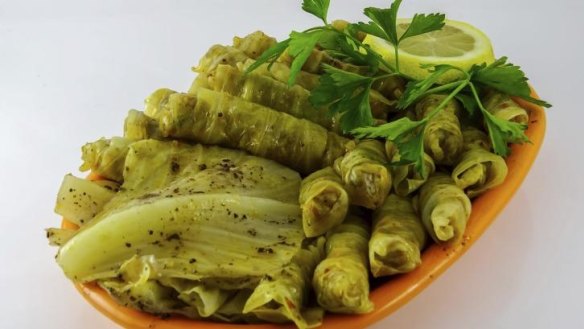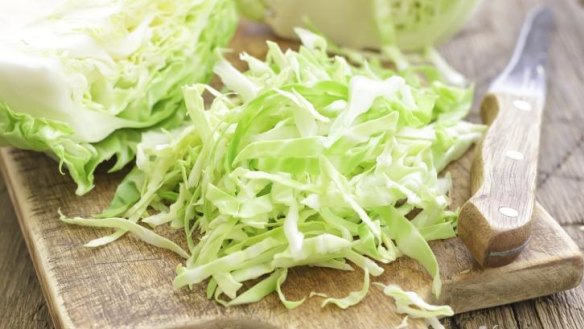Greek stuffed cabbage leaves: Owen Pidgeon's twist on classic recipe

Cabbages are a good choice as a winter crop. You can begin your own crop from seed, by using a propagation tray or you can plant out seedlings. They are a good source of beta carotene and Vitamin C, especially when you are eating the outer leaves of green cabbages.
This is one vegetable that can be planted sequentially through most of the year, if you can get the right varieties going, at the correct time. Gardeners speak about cabbages when they are to be harvested, so plant your seeds now for "spring cabbages". The smaller cabbages can be ready for harvest in 10-12 weeks. The autumn-maturing cabbages, including the savoys and the reds, will take 14-16 weeks. If you plant several of each variety, you can begin the harvest when the first heads are a little small, to provide for a good supply over several weeks.
This is one crop where the spacing between plants depends so much on the variety being grown. If you have little space available, then plant out sugarloaf cabbages and allow 45-50 centimetres between each plant. If you have plenty of space to go with the larger, late-maturing varieties then allow 60-70 centimetres between each plant.

Plant cabbage seedlings quite deep, burying all the stem and roots into the soil, even up to the first two leaves. The buried stem will produce some additional little roots that will serve to stabilise the top-heavy plant.
Cabbages need to grow in rich, fertile soil, so prepare your garden bed with plenty of finished compost and add in some pelletised organic fertiliser. Press the soil down to provide a firm base so the root system can have support as the heads become quite heavy.
Grow them on quickly so that they will form tight, thick heads, by providing regular waterings when there is no rain and regular liquid feeds of seaweed or fish emulsion solutions. Cabbages will motor along to maturity when the daytime temperatures are in the 15-20 degrees range.
Golden acre is a fine little early-maturing cabbage which produces light green heads weighing around 1.5 kilograms. It takes about 11 weeks to mature and is suitable for making coleslaw and spring rolls, as well as for steaming. Red express can produce firm deep red heads weighing up to 1.8 kilograms in nine weeks. It is crisp and tender and can be added to mesclun mixes. Sugarloaf is the other quick-growing cabbage. It is also called the Early Jersey Wakefield and dates back to 1840. The dark green head usually weighs 1 kilogram and it can also be harvested after eight or nine weeks.
Savoys are the wonderful large, crinkly-leaf cabbages. They are among the late-maturing varieties and can stand light frosts. They are excellent for using in salads. Drumhead, January king and green coronet are good options. Savoy vertus is an old French variety which yields good, sweet heads weighing up to 2.2 kilograms and is one of the best for making coleslaw It is quite cold tolerant.
Cabbages are a good survivor in winter. As well, late-maturing cabbages, if fully mature and undamaged, will keep for quite some time in a cool location, such as laying them on a tray in your garage or shed with some straw underneath.
Protecting from white cabbage moths
Protecting your plants from the white cabbage butterfly is one of the major concerns with growing any brassicas. The female looks beautiful as it flies around adorned with its two black spots on each wing, but is can devastate young and mature crops in no time.
Barrier cloths are probably the best option for home gardeners who want to avoid toxic chemicals. Mosquito nets are pretty suitable for small areas or frost nets. Green Harvest is one online supplier which sells a range of nets. You can also buy low-cost hoops to create a growing tunnel to cover the row of plants. Dipel is a natural-based product (approved organic) for controlling caterpillars that arrive on your plants. It contains Bacillus thuringiensis which only acts as a stomach poison on caterpillars. Mix with water and spray on both sides of the leaves.
Greek stuffed cabbage leaves
1 large savoy cabbage
250g beef mince
250g lamb mince
1 medium onion, chopped
2 cloves garlic, finely chopped
1 tbsp parsley, finely chopped
½ cup plain yoghurt
1 cup long grain rice
½ tsp oregano, crushed
salt and ground pepper
2 cups tomato sauce
2 bay leaves, crushed
1 cup beef stock
1 cup water
Remove 12 large cabbage leaves from the outside of the cabbage. Pour water into a heavy-based large pan to a depth of 20 millimetres and bring to the boil. Place the cabbage leaves in the boiling water and place the lid on the pan. Simmer for around 10 minutes until the leaves are limp. Drain and remove the leaves.
Mix the minces in a medium-sized bowl with the onion, garlic, parsley, yoghurt, rice and oregano. Add a pinch of salt and some ground pepper. Scoop out a generous tablespoonof the mixture and place on each cabbage leaf. Fold the two sides of the leaves in towards the centre and roll up tightly. Fasten with wooden toothpicks.
Take some smaller leaves from the cabbage and place them on the bottom of the pan. Then place six cabbage rolls on this protective cover and cover with a portion of the tomato sauce and crushed bay leaves. Repeat the process by placing the remaining rolls on top and covering with the remaining sauce and bay leaves. Pour in the beef stock and the cup of water. Cover and simmer for one hour. Serve with sour cream or yoghurt.
This week in the garden
* Plant out rocket and loose-leaf lettuce seedlings in a sunny location, sheltered against a north-facing brick wall or covered with a cold frame.
* Keep up the weeding around any garlic, onion and pea gardens you have planted, as they do not grow well with competition.
* If you have space at the back of your garden, prepare a good bed of soil with compost and plant out a row of raspberries or loganberries for early summer feasts.
* When pruning fruit trees, be prepared to trim back overlong branches and remove or cut back some small branches that are crowding the central parts of the tree.
* Use the winter days to dig better drainage of any waterlogged areas before the spring plantings.
Owen Pidgeon runs the Loriendale Organic Orchard near Hall.
Restaurant reviews, news and the hottest openings served to your inbox.
Sign up